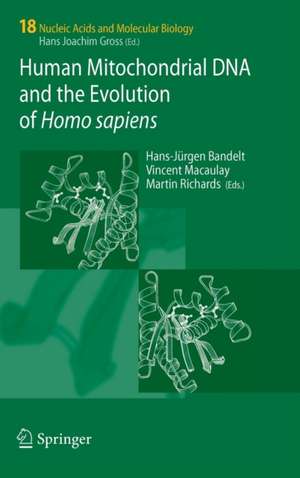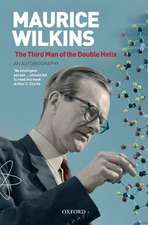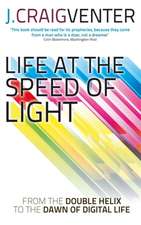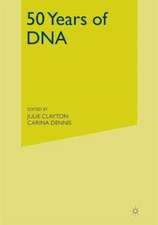Human Mitochondrial DNA and the Evolution of Homo sapiens: Nucleic Acids and Molecular Biology, cartea 18
Editat de Hans-Jürgen Bandelt, Martin Richards, Vincent Macaulayen Limba Engleză Hardback – 12 mai 2006
| Toate formatele și edițiile | Preț | Express |
|---|---|---|
| Paperback (1) | 980.31 lei 38-44 zile | |
| Springer Berlin, Heidelberg – 30 noi 2010 | 980.31 lei 38-44 zile | |
| Hardback (1) | 1102.31 lei 6-8 săpt. | |
| Springer Berlin, Heidelberg – 12 mai 2006 | 1102.31 lei 6-8 săpt. |
Din seria Nucleic Acids and Molecular Biology
- 18%
 Preț: 1111.53 lei
Preț: 1111.53 lei - 18%
 Preț: 1003.38 lei
Preț: 1003.38 lei - 15%
 Preț: 639.41 lei
Preț: 639.41 lei - 15%
 Preț: 647.08 lei
Preț: 647.08 lei - 15%
 Preț: 642.68 lei
Preț: 642.68 lei - 15%
 Preț: 642.36 lei
Preț: 642.36 lei - 18%
 Preț: 1822.76 lei
Preț: 1822.76 lei - 18%
 Preț: 1231.32 lei
Preț: 1231.32 lei - 20%
 Preț: 990.62 lei
Preț: 990.62 lei - 18%
 Preț: 956.99 lei
Preț: 956.99 lei - 15%
 Preț: 637.28 lei
Preț: 637.28 lei - 18%
 Preț: 1218.17 lei
Preț: 1218.17 lei - 18%
 Preț: 947.98 lei
Preț: 947.98 lei - 18%
 Preț: 1384.26 lei
Preț: 1384.26 lei - 18%
 Preț: 1227.52 lei
Preț: 1227.52 lei - 18%
 Preț: 1228.29 lei
Preț: 1228.29 lei - 18%
 Preț: 1225.79 lei
Preț: 1225.79 lei - 18%
 Preț: 942.13 lei
Preț: 942.13 lei - 18%
 Preț: 1222.62 lei
Preț: 1222.62 lei - 18%
 Preț: 950.03 lei
Preț: 950.03 lei - 18%
 Preț: 1216.02 lei
Preț: 1216.02 lei - 18%
 Preț: 953.20 lei
Preț: 953.20 lei - 18%
 Preț: 949.73 lei
Preț: 949.73 lei - 15%
 Preț: 646.30 lei
Preț: 646.30 lei - 18%
 Preț: 895.27 lei
Preț: 895.27 lei - 18%
 Preț: 1004.36 lei
Preț: 1004.36 lei - 18%
 Preț: 894.34 lei
Preț: 894.34 lei
Preț: 1102.31 lei
Preț vechi: 1160.32 lei
-5% Nou
Puncte Express: 1653
Preț estimativ în valută:
210.95€ • 229.06$ • 177.20£
210.95€ • 229.06$ • 177.20£
Carte tipărită la comandă
Livrare economică 22 aprilie-06 mai
Preluare comenzi: 021 569.72.76
Specificații
ISBN-13: 9783540317883
ISBN-10: 3540317880
Pagini: 288
Ilustrații: XIV, 271 p.
Dimensiuni: 155 x 235 x 23 mm
Greutate: 0.62 kg
Ediția:2006
Editura: Springer Berlin, Heidelberg
Colecția Springer
Seria Nucleic Acids and Molecular Biology
Locul publicării:Berlin, Heidelberg, Germany
ISBN-10: 3540317880
Pagini: 288
Ilustrații: XIV, 271 p.
Dimensiuni: 155 x 235 x 23 mm
Greutate: 0.62 kg
Ediția:2006
Editura: Springer Berlin, Heidelberg
Colecția Springer
Seria Nucleic Acids and Molecular Biology
Locul publicării:Berlin, Heidelberg, Germany
Public țintă
ResearchCuprins
Prerequisites and Caveats.- Mitochondrial DNA in Homo Sapiens.- The Transmission and Segregation of Mitochondrial DNA in Homo Sapiens.- Numts Revisited.- Estimation of Mutation Rates and Coalescence Times: Some Caveats.- Postmortem Damage of Mitochondrial DNA.- Lab-Specific Mutation Processes.- Evolution of Human mtDNA.- The World mtDNA Phylogeny.- The Pioneer Settlement of Modern Humans in Asia.- Ancient DNA and the Neanderthals.- A Model for the Dispersal of Modern Humans out of Africa.
Recenzii
From the reviews:
"The study of the variation in mitochondrial DNA has significantly deepened our knowledge about human dispersal … . The book is clearly written and benefits from the true experts in the field. … it provides a strong and helpful basis and serves as a well-selected summary … . everybody involved in mtDNA research is sooner or later advised to have a look at it." (Wolfgang Haak, Journal of Comparative Human Biology, Vol. 58, 2007)
"Mitochondrial DNA (mtDNA) has become prominent in studies … . mtDNA is a boon, not only for scholars interested in the origin of Homo sapiens, but also for population biologists, forensic scientists and those interested in the applications of ancient DNA techniques. … mtDNA has grown in parallel with advances in molecular biology, phylogenetics and bioinformatics. … This well-written book contains much valuable information on the received human mtDNA phylogeny and taxonomy." (Erika Hagelberg, Human Genetics, Vol. 123, 2008)
"This book reviews what mitochondria are, how these organelles are studied by geneticists, and what they tell us about our evolution. … is an excellent book that will appeal to several audiences. One is the human mitochondrial DNA research community. While the authors describe current research, they also offer a number of provocative reconstructions of human history … . The authors of this book have done a valuable service to the anthropological community." (Pamela R. Willoughby, American Journal of Physical Anthropology, Vol. 135, 2008)
"The study of the variation in mitochondrial DNA has significantly deepened our knowledge about human dispersal … . The book is clearly written and benefits from the true experts in the field. … it provides a strong and helpful basis and serves as a well-selected summary … . everybody involved in mtDNA research is sooner or later advised to have a look at it." (Wolfgang Haak, Journal of Comparative Human Biology, Vol. 58, 2007)
"Mitochondrial DNA (mtDNA) has become prominent in studies … . mtDNA is a boon, not only for scholars interested in the origin of Homo sapiens, but also for population biologists, forensic scientists and those interested in the applications of ancient DNA techniques. … mtDNA has grown in parallel with advances in molecular biology, phylogenetics and bioinformatics. … This well-written book contains much valuable information on the received human mtDNA phylogeny and taxonomy." (Erika Hagelberg, Human Genetics, Vol. 123, 2008)
"This book reviews what mitochondria are, how these organelles are studied by geneticists, and what they tell us about our evolution. … is an excellent book that will appeal to several audiences. One is the human mitochondrial DNA research community. While the authors describe current research, they also offer a number of provocative reconstructions of human history … . The authors of this book have done a valuable service to the anthropological community." (Pamela R. Willoughby, American Journal of Physical Anthropology, Vol. 135, 2008)
Textul de pe ultima copertă
Mitochondrial DNA is one of the most explored genetic systems because of what it can tell us about the human past. This volume takes a unique perspective, presenting the disparate strands that must be tied together to exploit this system. From molecular biology to anthropology, statistics to ancient DNA, this first volume of three presents the global picture of human mitochondrial DNA variation. It takes a critical look at the field, flagging the problems, as well as the successes, and always placing the mitochondrial phylogeny centre stage.
Caracteristici
Represents an unique analysis of the connection between variations in human mitochondrial DNA and the human past









